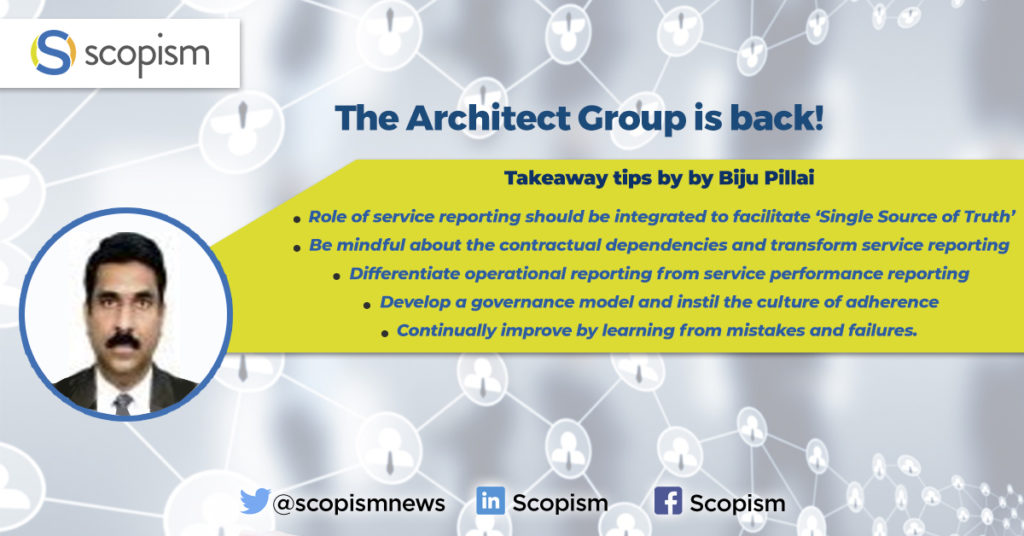Introduction
In a SIAM operations model, ecosystem service providers are expected to produce various types of reports to demonstrate their service performance as per the contractual agreements. Other than this, collaborating with all other ecosystem partners and the service integrator to facilitate the ‘Single Source of Truth’ is a vital responsibility of any such service provider.
This can be achieved only when the SIAM reporting is based on service outcomes rather than superficial reporting metrics. The reporting will not assume credibility if the data used does not come from a common service management tool.
To achieve an effective service reporting regime in a SIAM ecosystem, contractual dependency is crucial in driving cross-provider alignment and collaboration. Otherwise there is a risk that expectations will not be met as a service provider’s contractual obligations are not aligned with those of the service integrator. Therefore, there is a compelling reason to ensure that all the contractual requirements of service providers are aligned with those of the service integrator . Areas for consideration are SLAs, OLAs, data standards, templates and forms.
It is an inevitable fact that in any enterprise IT model, end to end services consist of contributions by several parties. Hence stakeholders should be mindful that enterprise IT to work more effectively, it requires not only a transformation map to define (CMDB, service maps, service catalogues, end to end SLAs etc.) and measure services but also a change of culture of the service delivery ecosystem. Orchestrated and uniform service experience are only achievable by collaborating each other. Unless the consequences of this are understood and appreciated by prospective clients, particularly their sourcing departments; it will be impossible to make any quantum impact just by service focused reporting as there will not be anything to focus on without a big picture stitched together.
This blog aims to provide some insights to develop practical service focused reporting for SIAM implementation projects.

Service Reporting Transformation
As mentioned above, the objective of service reporting must be to build competitive advantage and realized ‘value’ by adopting a strategy of transitioning the historical metrics-based reporting to more predictive and real time information management. Clients are less interested in what has happened rather than what might happen. Once achieved it will be a certain game changer as SIAM will be able to predict whether a service is going to meet the SLAs for the period and if not, initiate corrective measures before it is too late. According to my experience, this is only possible by interlinking all the operational processes and then reassessing the pattern of business activities to define business aligned service level requirements.
While a thoughtful and sound process approach is the first step, let’s not undermine the need to marry processes with technology. Service reporting transformation from ‘historical’ to ‘predictive’ can be expedited by investing in the right technology and orchestrating it well with the service integration tool platform. Technologies like AppDynamics and Dynatrace provide real-time service performance monitoring and measurement. This will help a lot in large SIAM implementations to develop a tool strategy, landscape and progressive roadmap to ensure the right level of technological capabilities will be available to enable a proactive view which aligns with business expectations.
While the SIAM model is tackling its maturity curve, more and more business service mapping will be developed at the CMDB level. These business services are the corner stones of transforming service reporting to service-focused real time information representation. It is worth mentioning that SIAM processes like problem management, availability and capacity management will help to improve the predictability of services, hence accelerating this journey.
Transformation of Service Reporting
Service reporting can be handled through two specific streams:
- Operational Report Management – Gather and publish operational performance at the tactical level. This facilitates processes and procedures to promote accurate and timely operational reports, and continual service improvement
- Service Performance Reporting – Aggregate performance at the ‘service’ level (for example overall performance of ERP services)
Operational and Performance Reports Management Policies govern the process of managing the administration and publication of reports; from compiling, publishing, and tracking, to resolving break/fix records, and managing report requests.
In situations where it is not possible or feasible to deploy the entire process, procedures, policies, and guidelines, the service provider may implement a slightly modified process with the same or better level of protection. Report stakeholders use reports to monitor the status and health of business functions and service activities (status, trends, snapshots, history, progress, volume, etc.).
Practical Recommendations
Every stakeholder involved in a SIAM implementation must realise the need to have end to end and transparent metrics to showcase the vitality and effectiveness of IT services.
- Ensure existing service levels as agreed in the contracts are met for all the service providers.
- Performance of SIAM ecosystem partners to be reported by SIAM. Whereas performance of Service Providers who are not part of SIAM ecosystem to be reported by client contract management team.
- Provide a seamless mechanism to monitor and report the SLA compliance across service providers. Influence them to use the common service management platform rather than investing in expensive and time taking technical integrations.
- Transform SLA models to end to end, business aligned SLAs
- Identify useful service metrics
Below provided are some thoughts related to few of the process areas to give an indication.
Service Catalogue Management
Useful metrics:
- Proportion of service requests that are requested through Service Catalogue – Measure of Service Catalogue Effectiveness.
- Percentage of decrease in ‘requests for information’ about IT and Business services – Shows increase in knowledge of services listed in the service catalogue.
Service Request Management
Useful metrics:
- Total request elapsed time,
- Categories of various requests,
- Open Service Requests by tower, and
- Trending report.
Major Incident Management
Useful metrics are:
- Number of tickets accepted by the resolver teams within agreed time frame,
- Number of MIM tickets resolved as per SLA,
- Number of Problem Tickets invoked against Major Incidents,
- Major Incidents Vs Service Availability, and
- Average duration of cross time Major Incidents to resolve.
Configuration Management
I feel metrics defined at the operational level (like no. of CIs with relationship mapped, assets without valid asset tags, etc.) are not often relevant to the business. Hence, it is advised to invest effort in developing strategic metrics which can meaningfully showcase business value.
Some examples are:
- Percentage of asset lifecycle cost down,
- Risk Probability Number (RPN) from compliance and legal issues,
- Cost benefit due to license harvesting,
- Data quality and completeness,
- Operational and service benefits like reduced MTBF.
Role of Governance
A robust governance structure is required to incorporate the following elements:
• The report produced should reflect integrated reporting capability which details contract-based performance adherence rather than mere reflection of tactical metrics.
• Using the service focused reports in various SIAM governance meetings to identify compliance and non- compliance.
• Process control through audits to identify and correct variations.
• A mechanism to address and resolve disputes between client, service providers, third parties and service integrator
The SIAM model will become permeable in no time if a uniform and credible information management can not be represented to the stakeholders. A little effort will go a long way to success.

Takeaways
Service performance indicators and ability to report those are very crucial to prove the value of the SIAM service. This is not something that will unfold with out investing adequate effort in developing a practical approach. While doing it; the following key points to be considered.
- Role of service reporting should be integrated to facilitate ‘Single Source of Truth’
- Be mindful about the contractual dependencies to gather, process and produce useful metrics.
- Transform service reporting to predictive metrics which will reflect the right level of service performance.
- Differentiate operational reporting from service performance reporting
- Develop a governance model and instil the culture of adherence
- Continually improve by learning from mistakes and failures.
Author profile

Biju Pillai has more than 20 years of experience in Information Technology Consulting and is a contributing author and reviewer of SIAM Foundation & Professional BoKs. He is part of SIAM and ServiceNow CoE of Capgemini and based out of Melbourne, Australia. Biju played pivotal roles in several large SIAM implementations across the world. He can be contacted on bijupillai2008@yahoo.com or +61 426063540.



